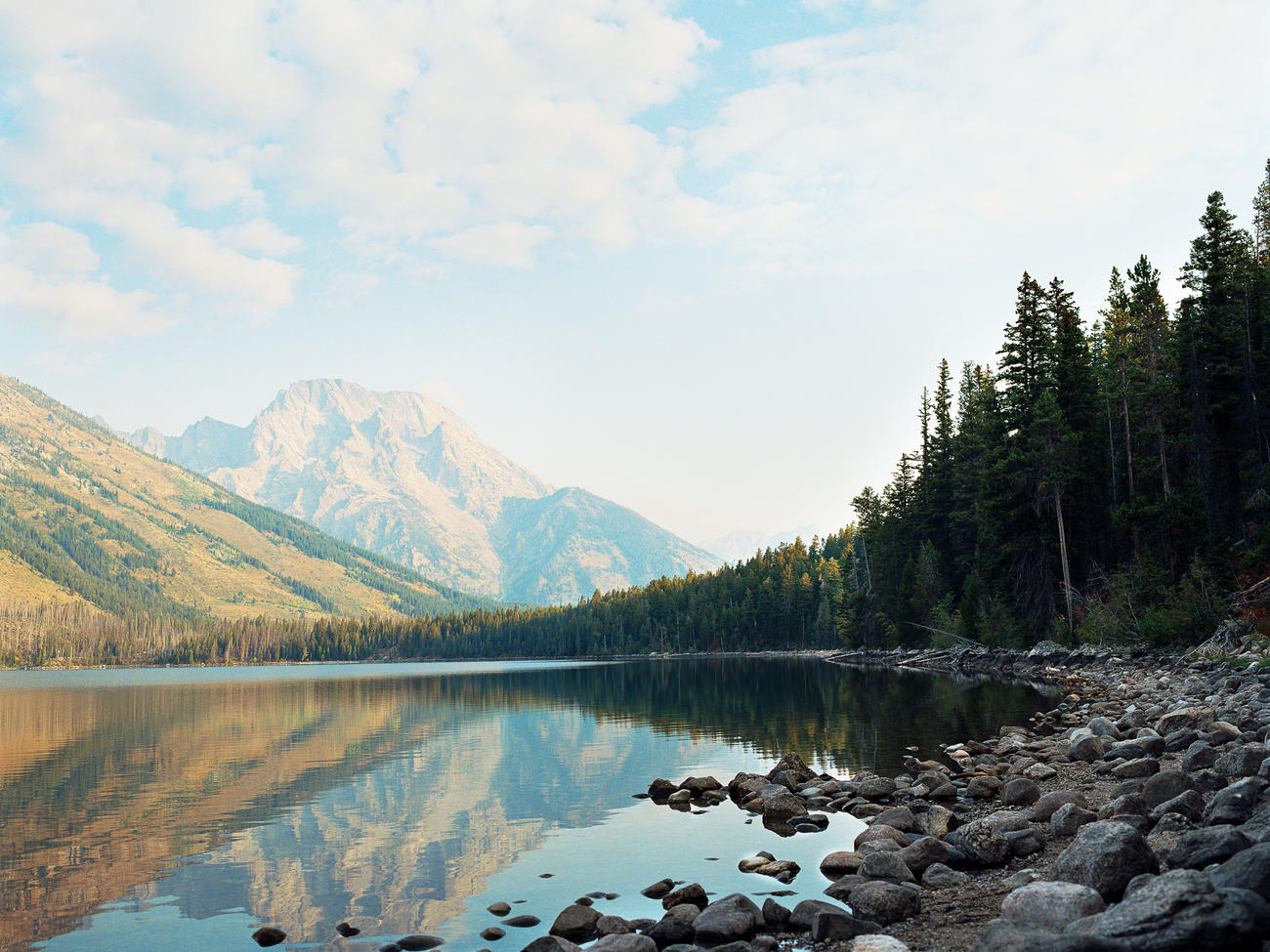
Teton-Bound

Lined by cottonwoods, the Snake River reflects the high sun of a summer afternoon, shimmering and slithering along the floor of Jackson Hole. Beyond the Snake, the snowcapped peaks of the Teton Range, jagged like a row of shark’s teeth, cut a serrated line high into the Wyoming sky, rising above the valley and river to create one of the American West’s iconic landscapes in Grand Teton National Park.
Grand Teton is national park as national anthem―the very epitome of purple mountain majesties, where quite literally the buffalo roam and the deer and the antelope still play. These aren’t merely lyrical evocations of a lost frontier but true descriptions of what survives and can be found in this revered Wyoming park each and every summer day.
At a time when everyone from kindergartners to corporations focuses on the Earth’s fragility, here is a place to reconnect with the wild and, perhaps, to understand just a bit better where we all fit in.
“The range is sacred―there is an intangible power to this place,” says Joan Anzelmo, who spent 12 years here and was the park’s chief of public affairs. “The physical beauty, the different light at different times of day just captivates you. And it speaks to the souls of so many people.”
For all of its timeless appeal, Grand Teton National Park is also having one of its most eventful years since its 1929 founding. This summer a hidden jewel will be revealed: The 1,106-acre Laurance S. Rockefeller Preserve (or LSR Preserve) opens in early September. Its state-of-the-art visitor center and the park’s new interpretive facility will both be among the most environmentally advanced buildings in the entire national park system.
Journey to the mountains
Somewhere in the middle of nowhere in Idaho, my wife, Becky, and I are Teton-bound. And as easy as it is to conjure the grandeur of these mountains from memory, the blunt reality is that the Tetons are just a big black wall to the east. Consistent with a most regrettable family tradition, we will be arriving in yet another one of the world’s most spectacular places at night. This is not by design. A flight delay has resulted in 120 miles of moonless mountain driving. The last climb is over 8,431-foot Teton Pass, the slow third-gear ascent through the Tetons. Fifteen hours into the travel day, it seems like a final test―Here, Mr. Sisyphus, would you care for another boulder?―when, beyond the summit, the pass opens to a full moon rising. It lights the forest and, beaconlike, guides us into the valley of Jackson Hole.
Despite our midnight arrival, it’s hard to sleep in, and the next day around dawn I head into the park. Down in a bog below a dirt road, there’s some movement.
Well, good morning, Mr. Moose.
He is a sight for still-world-weary eyes, this languid, antlered chap, loudly munching and standing knee-deep in a pond so still that it reflects the mountains with a mirror’s precision. Moving lazily to another branch, he sends ripples gliding across the pond before disappearing into the opposite bank.
To the sound of breaking branches and rustling leaves, the moose moseys into the forest, his morning repast complete. And as an osprey flies overhead and a pair of elk works its way up a slope, the world of airport lines recedes like a bad dream upon awakening.
Mr. Rockefeller’s ranch is now yours
Still, this is not just a story of moose and men but of mountains too. And I haven’t even reached my destination, Jackson Point Overlook, perhaps the park’s best. Which is saying a lot.
Heading north, Teton Park Road opens up to unbelievable drive-by vistas of the mountains, which rise to nearly 14,000 feet. Washed by the morning’s pink light, the blue granite glows red like dying embers.
Jackson Point sits atop the modest mound of Signal Mountain, just 7,593 feet but with an opera-box perspective opposite the Tetons. In 1872 photographer William Henry Jackson captured the view, giving the world its first look at the range. Now about 4 million people a year visit Grand Teton National Park, doing everything from rafting trips along the Snake to multiday climbs to the summit of the park’s highest peak, the 13,770-foot spire that is simply known as Grand Teton.
Explore the 1,106-acre Laurence S. Rockefeller Preserve (or LSR Preserve) on the shore of Phelps Lake. Opened in 2008, its state-of-the-art visitor center and the park’s interpretive facility are among the most environmentally advanced buildings in the entire national park system.
So when 1,106 acres of pristine forested land open to the public, that’s big news. The LSR Preserve is named for Laurance S. Rockefeller, whose celebrated family played an integral role in the park’s founding. The preserve consists of the family ranch along Phelps Lake, a parcel the Rockefellers held on to for decades after donating more than 33,000 acres of their land to the park.
Hike the preserve’s new trails to the edge of the lake and you’ll see no trace of the ranch. That was according to the wishes of “Mr. Laurance,” as he was known to longtime Grand Teton figure Clay James, local project manager of the preserve and its visitor center.
James has played a variety of roles around the park since he first worked here in 1962 as a college student. But returning the ranch to its natural state posed a new range of challenges. Seven miles of asphalt were removed and ground up for reuse. A 150-ton crane hoisted buildings―some of them dating back to the early 1900s―onto trucks that moved them to other locations in Jackson Hole. Workers even used a pneumatic trailer that could be tilted and raised as necessary to avoid disturbing boulders as the buildings were hauled out.
“We had one mirror break. That was about it,” James says. And apparently no boulders. Now this beloved retreat that presidents once visited is again the exclusive home of elk herds and the bears that come to gorge on hawthorn berries in early fall. As for the rest of us, we’re just plenty lucky to finally visit.
“It’s a great gift to the American people,” James says, looking out across the lake from the onetime ranch site. “A tremendous gift.”
A personal sense of wilderness
Becky and I head up to Jackson Lake Lodge for a pre-hike lunch at Pioneer Grill, a ’50s diner where everyone sits elbow-to-elbow around U-shaped counters. I’m partial to their buffalo burgers, although after watching the snorting grandeur of a herd trundle across Antelope Flats Road earlier in the morning, I’m feeling guilt that’s hardly assuaged by the knowledge that my meal was raised elsewhere.
The food chain is less of an abstract concept at Grand Teton National Park than it is in most places. In the Tetons, it’s impossible―and unwise―to ignore the many warnings about black and grizzly bears. Visitor centers sell bear repellent, and hikers can be seen with canisters dangling at the ready from their necks and jangling noisemakers on their boots designed to alert bears of their approach―not, as some have grimly joked, to sound the dinner bell.
We have seen bears at a distance and never come close to a confrontation. But, perhaps still unnerved by our travel day, we clap more and talk a little louder than usual as we hike up Cascade Canyon. The first leg of the trip is a boat crossing―really a ritual passage―across Jenny Lake, followed by a crowded first stretch to a pair of the park’s most popular destinations: the not-so-hidden Hidden Falls and the truly inspiring Inspiration Point.
From there the crowds thin, even though the beauty only deepens as the glacially carved canyon leads into the very heart of the Tetons. To be inside the range is to transcend the familiarity of all of those photos that glory in the Tetons’ profile from Jackson Hole. There’s a feeling of being pulled into the mountains as the sounds of Cascade Creek fill the lush forest of fir and spruce before the woods open to a new perspective on the peaks.
Here the Tetons are a living place, not a silent, monumental backdrop. Raspberries and thimbleberries hang heavily from shrubs. Our eyes follow the foaming flow of a waterfall and cascade, which trace the gap of a side canyon up through a thick forest to a snowfield set beneath the great gray triangle of 12,928-foot Mt. Owen. Trout zip through shallow pools, and picas―small rabbitlike animals―dart in and out of gaps on a huge boulder slide, their bleating calls out of proportion to their decidedly modest stature.
We see more moose, sunbathing marmots too. Yet, alas, no bears. Then, on our return to the boat dock, a fast-moving storm rages in. Its thunder, which began as a distant kettledrum murmur, approaches with ever-sharper cracks that rock the canyon, rattling us in the process. As the gap between flashes of lightning and thunder closes, Becky shifts into a hiking overdrive, and suddenly I can barely keep up with her pace.
We are, in a word, scared. Scared less of imminent personal catastrophe than shaken by the unfamiliar sensation of smallness in these huge and powerful mountains. But you know what? It’s liberating and energizing to experience the Tetons on such a visceral level. The wild is not some abstract other that’s found elsewhere; for the next few miles, it’s our entire world. As Mardy Murie―the great conservationist who lived in the shadow of the Tetons for 76 years―once said, “My sense of wilderness is personal. It’s the experience of being in wilderness that matters, the feeling of place.”
We are feeling cold and wet yet exhilarated too as we finally reach the dock. The storm has blown through and the clouds begin to break up. Fog drifts between the peaks, the Tetons slowly receding yet looking bigger than ever as the boat slowly chugs back across Jenny Lake.
